Modular Blockchain Technology Represents a More "Soulful" Approach to Plug-and-Play Products
Author: @twilight_momo
Advisor: @CryptoScott_ETH
TL;DR
Monolithic Blockchain is known for its comprehensiveness, independently handling various aspects of the network, from data storage to transaction verification, and more. On the other hand, Modular Blockchain separates different functions of the blockchain into independent modules, providing performance support and a smooth user experience in specific functions, to some extent solving the "impossible triangle" problem.
Ethereum as the first blockchain platform to support smart contracts has provided fertile ground for modular design. With the development of blockchain technology, the Bitcoin ecosystem has also begun to explore the possibility of modularity by adding new modules to achieve advanced functionality, such as improved privacy protection, more efficient transaction processing, or enhanced smart contract functionality.
Modular technology represents a more "soulful" plug-and-play product concept, and in the future, more flexible and customizable blockchain solutions will emerge, where various services and functions can be easily inserted and removed like LEGO bricks. This flexibility allows developers to quickly build and deploy blockchain solutions according to specific application needs.
1. What is Modular Blockchain

source: Celestia.org
When discussing modular blockchain, it is necessary to first understand the concept of Monolithic Blockchain. Monolithic chains, such as Bitcoin and Ethereum, are known for their comprehensiveness, independently handling various aspects of the network, from data storage to transaction verification, and smart contract execution. In this process, monolithic chains play the role of a "generalist," covering all aspects.
Taking Ethereum as an example, a mature monolithic blockchain can generally be roughly divided into four architectures:
- Execution Layer
- Settlement Layer
- Data Availability Layer (DA Layer)
- Consensus Layer
The following image uses the analogy of accounting on the blockchain to explain the role of each architectural layer in detail:
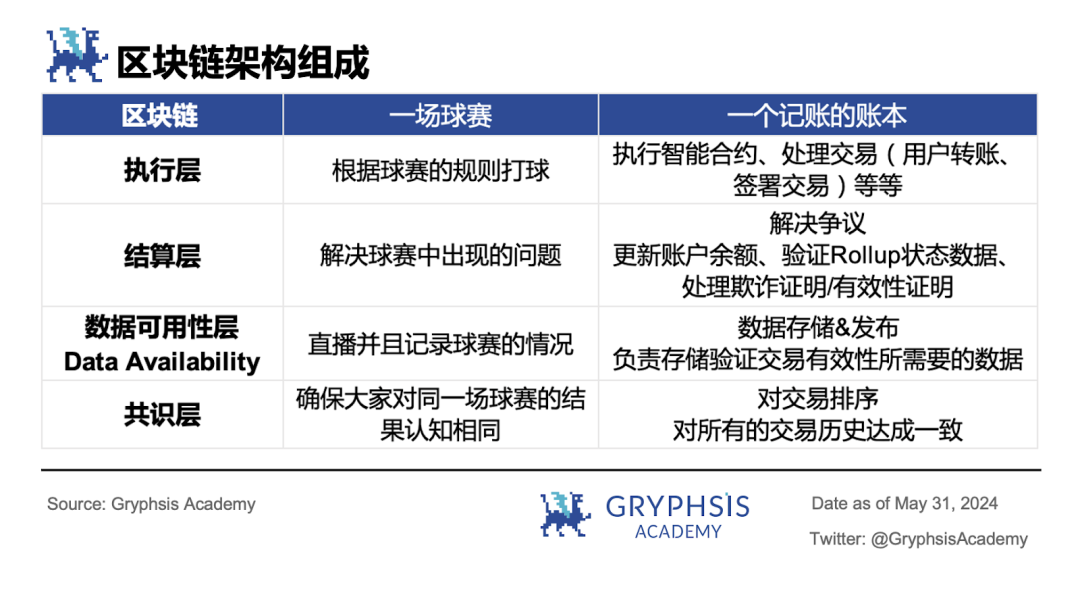
Through this analogy, we can better understand how the various architectures of the blockchain work together. A monolithic blockchain concentrates all functions on a single chain, while Modular Blockchain is a new type of blockchain architecture that decomposes the blockchain system into multiple specialized components or layers, with each component responsible for specific tasks, such as consensus, data availability, execution, and settlement.
Modular blockchain is like a group of specialists, focusing on in-depth exploration and technological innovation in their respective fields. This focus allows modular blockchain to provide excellent performance and user experience in specific functions. For example, they can provide faster transaction processing at lower costs.
In terms of node architecture, monolithic chains rely on full nodes, which must download and process a complete copy of the blockchain data. This not only places high demands on storage and computing resources but also limits the speed of network expansion. In contrast, modular blockchain adopts a light node design, only needing to process block header information, significantly improving transaction speed and network efficiency.
A significant advantage of modular blockchain is its flexibility and collaboration. They can outsource non-core functions to other specialists, creating a collaborative effect that significantly improves overall performance. This design philosophy is similar to LEGO bricks, allowing developers to freely combine different modules according to project requirements, creating diverse solutions.
While monolithic chains have advantages in global control, security, and stability, they also face challenges in scalability, upgrade difficulty, and adapting to new requirements. Modular blockchain stands out for its high flexibility and customizability, simplifying the creation and optimization of new blockchains.
However, modular blockchain also faces its unique challenges. Its complex architecture increases the workload for developers in design, development, and maintenance. As an emerging technology, modular blockchain has not yet undergone comprehensive security testing and market fluctuations, and its long-term stability and security still need further verification.
2. Why Modular Blockchain is Needed
Why is modular blockchain technology widely anticipated as a "future trend"? This is closely related to the well-known "impossible triangle" theory in the blockchain field.
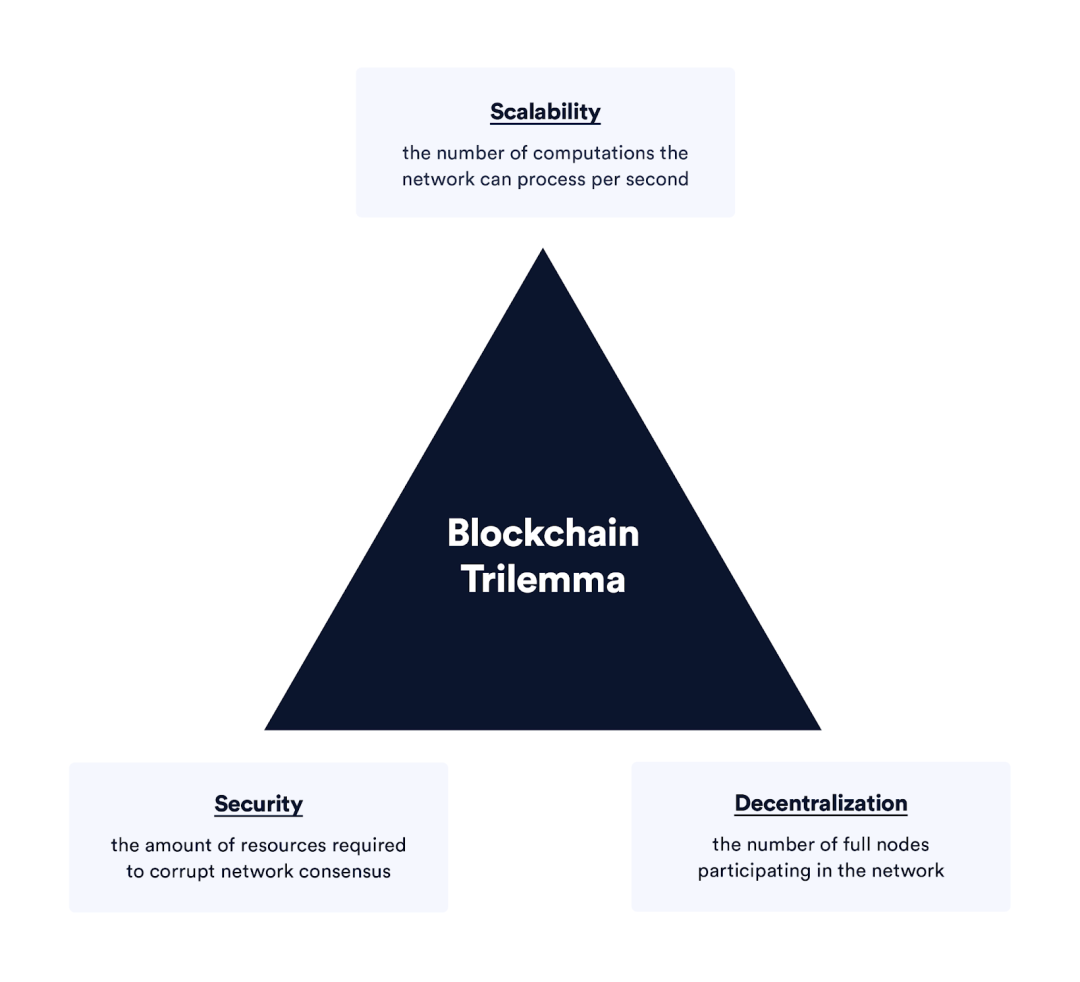
Source: chainlink
The "impossible triangle" of blockchain refers to the difficulty of a blockchain network achieving optimal states in security, decentralization, and scalability at the same time.
- Scalability concerns the network's ability to process a large number of transactions and maintain efficient, low-cost operation as user and transaction volume grow. It is usually measured by TPS (transactions per second) and latency (time required for transaction confirmation).
- Security involves the cost and difficulty of protecting the blockchain network from attacks. For example, Bitcoin's POW mechanism requires an attacker to control over 51% of the network's computing power, while Ethereum's POS mechanism requires collusion of over 1/3 of the nodes.
- Decentralization describes the operation of the network not relying on a single central node but being distributed across numerous nodes. The more nodes and the wider geographical distribution, the higher the decentralization of the network.
The core idea of the "impossible triangle" is that a blockchain system is difficult to achieve optimization in all three properties. For example, among many public chains, Bitcoin and Ethereum stand out in decentralization and security due to their widespread node distribution and sufficient number of nodes.
However, they sacrifice a certain level of scalability, resulting in slow transaction speeds and high transaction fees: Bitcoin's block time is approximately 10 minutes, and Ethereum's TPS is about 13. During periods of high transaction volume, Ethereum's transaction fees can be as high as hundreds of dollars.
It is in this context that modular blockchain technology has emerged, solving the scalability and transaction cost challenges of traditional public chains by assigning different functions to specialized modules. For example, technologies like Bitcoin's Lightning Network and Ethereum's Rollup are manifestations of modular thinking.
The advantage of modular blockchain lies in its layered architecture, allowing each layer to be optimized for specific needs. The data layer can focus on data storage and validation, while the execution layer can handle smart contract logic. This separation not only improves performance and efficiency but also promotes interoperability between different blockchains, laying the foundation for building an open and interconnected ecosystem.
In summary, modular blockchain technology provides a new approach to overcoming the limitations of traditional public chains. While maintaining decentralization and security, it achieves higher scalability and lower transaction costs, holding profound significance for the widespread application and long-term development of blockchain technology.
3. Modular Blockchain Race - Project Analysis
Based on its architectural characteristics, modular blockchain can be divided into different types. Among these types, the data availability layer and consensus layer are often designed as a unified whole due to their close interdependence. This is because when nodes receive transaction data, they usually also determine the order of transactions, which is the core of blockchain security and immutability.
Based on this design principle, we can understand different projects of modular blockchain from the aspects of execution layer, data availability layer and consensus layer, and settlement layer.
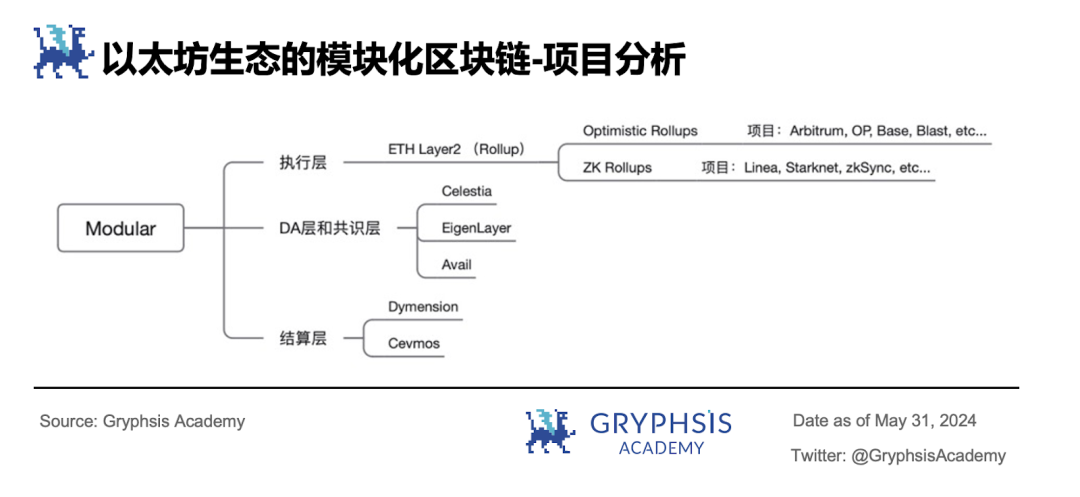
3.1 Execution Layer
Layer 2 technology, as an extension of the execution layer in blockchain architecture, is a manifestation of the concept of modular blockchain. It aims to improve the scalability of the main chain by building off-chain networks, systems, or technologies on top of the underlying blockchain.
Layer 2 solutions allow for faster and more cost-effective transaction processing while maintaining the security and decentralization of the underlying blockchain. According to the dashboard created by @0xning, it can be seen that the gas consumption for Layer 2 verification and settlement in the Ethereum ecosystem averages less than 10%, significantly reducing user transaction costs.
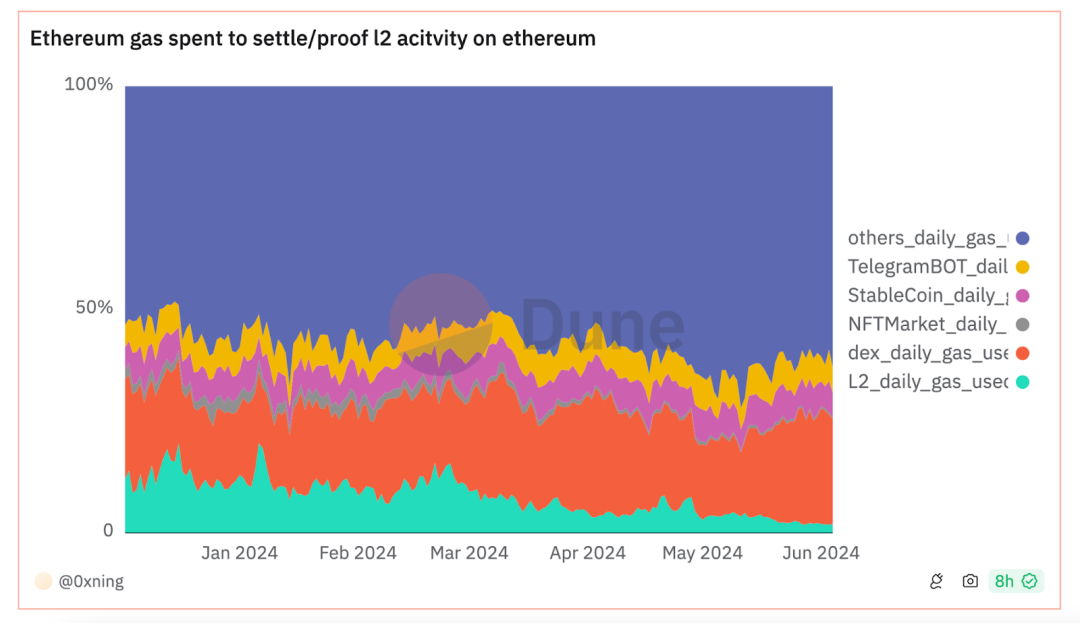
source: https://dune.com/0xning/ethereum-gas-war
Rollup technology is currently the most mainstream solution for Layer 2, with the core concept of "off-chain execution, on-chain verification," where computations are executed off-chain and then the calldata is uploaded back to the mainnet.
Off-chain Execution
In the Rollup model, transactions are executed off-chain, and the underlying blockchain is only responsible for verifying transaction proofs in smart contracts and storing the original transaction data. This design significantly reduces the computational burden on the main chain, reduces storage requirements, and allows for more efficient transaction processing.
To further reduce costs, Rollup uses transaction batching. This can be compared to consolidating goods in logistics; sending each item individually would incur high shipping costs. Rollup technology significantly reduces the cost of each transaction by batching multiple transactions together for a single "shipment."
On-chain Verification
On-chain verification is crucial for the security of Layer 2 networks. Layer 2 networks must provide cryptographic proofs to resolve potential discrepancies on the underlying blockchain. Currently, the two mainstream proof mechanisms are fraud proofs and validity proofs, supporting Optimistic Rollups and ZK Rollups, respectively.
Fraud Proofs for Optimistic Rollups
Optimistic Rollups operate on an optimistic assumption that all transactions are valid unless there is clear evidence of an error. This model relies on fraud proofs (challenges) during a challenge period, where any network participant can submit proof to challenge the state of a smart contract, ensuring fairness and transparency in the network.
According to L2BEAT data, there are a total of 16 Layer 2 solutions using the Optimistic Rollups mechanism, such as Arbitrum, OP, Base, Blast, and more.
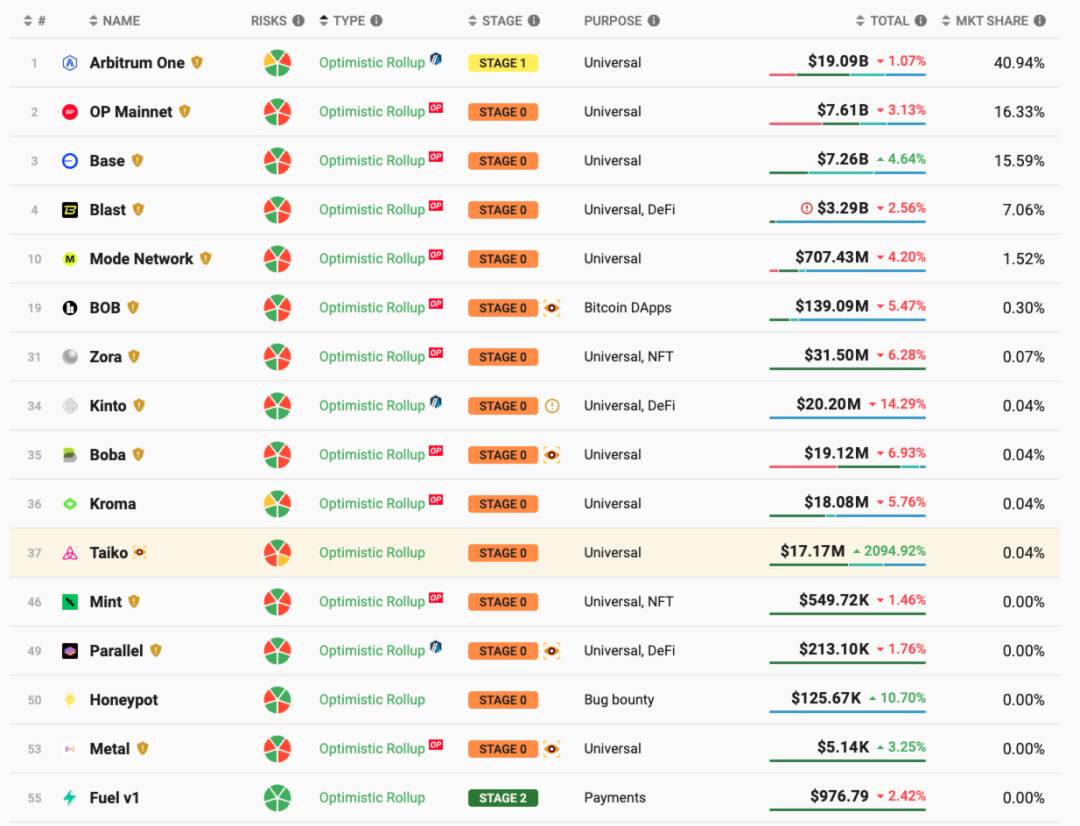
Source: l2beat.com
Validity Proofs for ZK Rollups
In contrast to Optimistic Rollups, ZK Rollups take a more cautious approach, requiring all transactions to undergo validity proofs before being accepted. This proof mechanism acts as a verification process, ensuring that every transaction and computation in the Layer 2 network is accurate and error-free.
In summary, validity proofs are the cornerstone of ZK-Rollups, requiring each batch of transactions to be accompanied by corresponding proofs, ensuring that smart contracts on the underlying blockchain can verify and approve state changes. For validating nodes, ZK Rollups provide a zero-error settlement mechanism, as each transaction must undergo strict validity verification.
According to L2BEAT data, there are a total of 11 Layer 2 solutions using the ZK Rollups mechanism, such as Linea, Starknet, zkSync, and more.
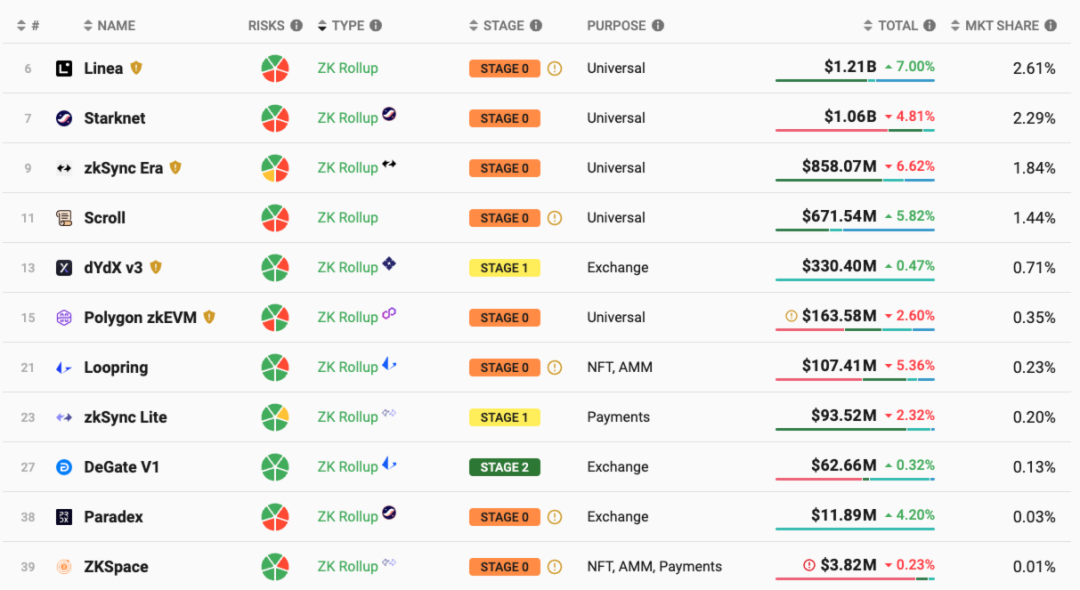
Source: l2beat.com
3.2 Data Availability Layer and Consensus Layer
3.2.1 Celestia

Celestia, as a pioneer in the modular blockchain field, is essentially a data availability layer, providing a solid foundation for dApps and Rollup development. By deploying on Celestia's data availability and consensus layers, application developers can focus on optimizing execution logic while leaving the complexity of data availability and consensus mechanisms to Celestia.
Celestia's architectural design provides diverse solutions for modular expansion, primarily including the following types:
Sovereign Rollup: Celestia provides the data availability and consensus layers, while the settlement and execution layers are independently implemented by their respective sovereign chains.
Settlement Rollup (e.g., Cevmos project): Building on Celestia's DA and consensus layers, Cevmos provides settlement layer services, with the application chain taking on the role of the execution layer.
Celestium: Celestia is responsible for the data availability layer, while the consensus and settlement layers rely on Ethereum's robust network, allowing the application chain to focus on the execution layer.
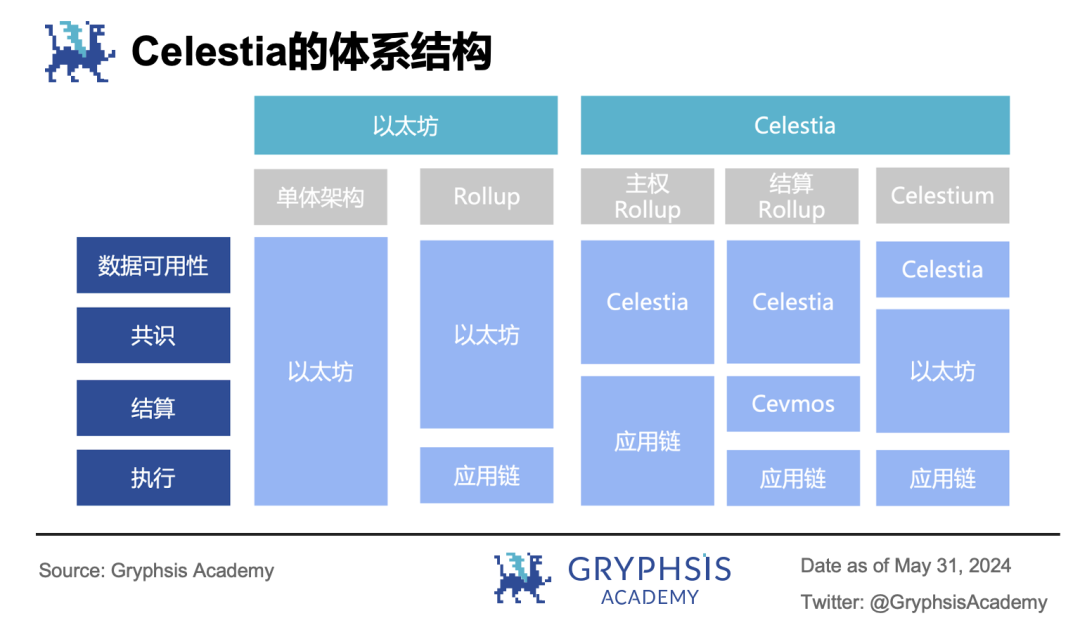
Celestia has implemented several innovative technologies, significantly reducing data storage costs and optimizing storage efficiency.
Erasure Code Technology
One of Celestia's innovations is the application of erasure codes. In the paper "Data Availability Sampling and Fraud Proofs" co-authored by Mustafa Albasan (one of Celestia's founders) and Vitalik Buterin, a new architectural concept is proposed, where full nodes are responsible for block production, and light nodes are responsible for block verification. Erasure code technology introduces redundancy in data transmission, ensuring that even with up to 50% data loss, the original data blocks can be fully recovered.
This mechanism means that to ensure 100% data availability, block producers only need to publish 50% of the block data to the network. If malicious producers attempt to tamper with 1% of the block data, they would actually need to tamper with the entire 50% of the data, greatly increasing the cost of malicious behavior.
Data Availability Sampling
Celestia addresses blockchain scalability issues by introducing Data Availability Sampling (DAS) technology. The workflow of DAS includes the following key steps:
Random Sampling: Light nodes perform multiple rounds of random sampling of block data, requesting only a small portion of the block data each time.
Gradual Confidence Building: As light nodes complete more rounds of sampling, their confidence in data availability gradually increases.
Reaching Confidence Threshold: Once the light nodes reach a preset confidence level (e.g., 99%) through sampling, they consider the block data to be available.
This mechanism allows light nodes to verify the availability of block data without downloading the entire block data, ensuring the integrity and availability of blockchain data. Celestia focuses on providing data availability rather than execution status, which increases block production rates, allowing each block to have more space to accommodate more sampled data, significantly increasing TPS (transactions per second).
3.2.2 EigenLayer
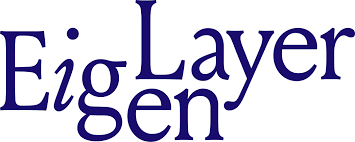
EigenDA is a secure, high-throughput, and decentralized data availability service, the first Active Verification Service (AVS) launched on EigenLayer. AVS can be understood as node operators, a subset of the thousands of node operators on Ethereum, who, in addition to their primary role (responsible for Ethereum consensus verification), take on additional tasks (serving networks with consensus verification needs such as rollups) to earn extra income.
With the increasing amount of re-staked Ethereum and more AVS joining the EigenLayer ecosystem in the future, Rollups can achieve lower transaction costs and higher security composability within the EigenLayer ecosystem.
EigenLayer is a re-staking protocol based on Ethereum, utilizing Ethereum's stakers as validators, leveraging Ethereum's partial security to avoid trust risks associated with centralized service providers or native tokens, thus lowering the development threshold for other projects. It also enhances Ethereum's trust network, increasing the value and influence of Ethereum.
In terms of architecture, EigenDA uses ZK technology to verify the state data submitted by Layer 2, and the EigenDA network, secured by Restaking ETH, is responsible for final determinism, ultimately submitting and storing Layer 2 state data on the Ethereum mainnet. Therefore, EigenDA acts as a subcontractor for the verification and final determinism of the DA service on the Ethereum mainnet, rather than a competitor like Celestia.
3.2.3 Avail

Avail is a modular blockchain project announced by the Polygon team in June 2023, spun off from Polygon as an independent entity in March of this year. Avail is currently running on the testnet and recently completed a $43 million Series A financing round, jointly led by Dragonfly and Cyber Fund.
The core architecture of Avail consists of three main parts: Avail DA, Avail Nexus, and Avail Fusion. Avail DA is a modular data availability layer, similar to Celestia, providing DA services for various blockchains. Avail Nexus is a standardized cross-chain messaging protocol, similar to Cosmos' IBC protocol, facilitating interactions between different cross-chains. Avail Fusion introduces a multi-asset staking POS consensus, aiming to provide secure consensus for the entire Avail network.
In terms of technology, Avail DA uses Kate polynomial commitments to avoid fraud proofs, does not assume that the majority of nodes are honest, and does not rely on full nodes to obtain data availability. This is different from Celestia's architecture, which is based on fraud proofs, resulting in fundamental differences between the two at a technical level.
With the emergence of modular data availability blockchain projects such as Celestia and Avail, the competition in the modular DA War will become increasingly intense, and Ethereum's functionality as a DA layer may be diverted, potentially leading to a "one super, multiple strong" competitive landscape in the future.
3.3 Settlement Layer
3.3.1 Dymension

Dymension is a modular blockchain platform based on Cosmos, providing a concise framework for RollApp development through built-in scalability aggregation technology. In Dymension's architecture, developers can focus on implementing business logic, using the Rollup Development Kit (RDK) and dedicated settlement layer to quickly deploy Rollup for specific applications.
Dymension's architecture consists of two core components: RollApp and Dymension Hub.
RollApp is the fusion of Rollup and App, a high-performance modular blockchain dedicated to specific applications on Dymension. RollApp can take various forms, including but not limited to dedicated Layer 2 solutions for decentralized applications such as DeFi platforms, Web3 games, NFT marketplaces, etc.
In RollApp, the sequencer plays a crucial role, responsible for local transaction verification, sorting, and processing. After block packaging, this data is transmitted to peer full nodes and published on the data availability network chosen by RollApp, such as Celestia. Upon receiving a response from Celestia, the sequencer sends its state root to Dymension Hub for consensus formation and settlement.
Dymension Hub, as the central component of the entire ecosystem, functions as the consensus and settlement layer. It receives state roots from RollApp to provide final transaction confirmation and settlement services for RollApps.
With this design, Rollup can delegate the tasks of consensus and settlement to Dymension Hub, while delegating the storage and verification tasks to DA networks like Celestia. This allows Rollup to share the economic security of these two networks while focusing on improving the execution efficiency and user experience of the application itself.
3.3.2 Cevmos
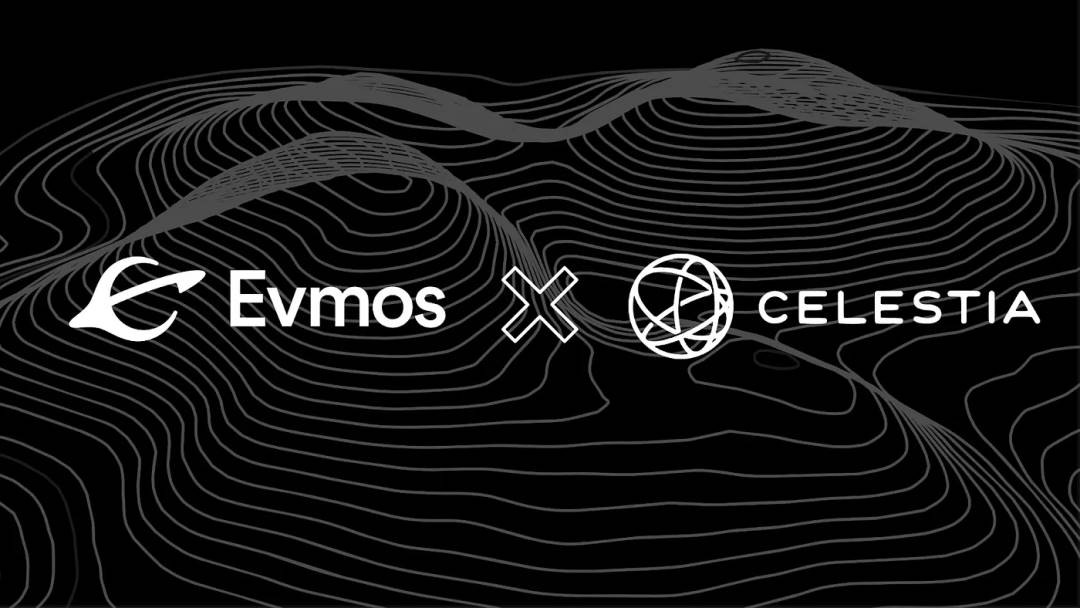
Cevmos combines Celestia, EVMos, and CosmOS, aiming to provide a settlement layer for EVM-compatible rollups.
As Cevmos itself is a rollup, all rollups built on it are collectively referred to as settlement rollups. Each rollup achieves redeployment of existing rollup contracts and applications on Ethereum through a minimal bidirectional trust bridge with Cevmos rollup, reducing migration effort. Rollups on Cevmos publish data to Cevmos, which then processes the data in batches before publishing it to Celestia. Like Ethereum, Cevmos acts as the settlement layer to execute rollup proofs.
- Modular Blockchain in the Bitcoin Ecosystem
With the wealth effect brought by the Ordinals protocol and the approval of the Bitcoin ETF, multiple positive factors have injected new vitality into the Bitcoin ecosystem. The market's attention has quickly turned to the Bitcoin ecosystem, and institutional investor funds have flowed into this area, demonstrating confidence and expectations for the future development of the Bitcoin ecosystem.
In this context, Bitcoin Layer 2 technology presents a thriving scene, with numerous technical solutions emerging, forming a diverse and vibrant technical ecosystem. Various innovative solutions have emerged, collectively driving the expansion and optimization of the Bitcoin network.
Although the industry has not yet reached a unified consensus on the precise definition of Bitcoin Layer 2, this article will draw on the concept of modular blockchain in Ethereum to explore the possibility and methods of building Bitcoin Layer 2 from a modular perspective.
4.1 Why Bitcoin Needs Modularity
The Ethereum network is known for its Turing-complete smart contract functionality, capable of storing and verifying historical states, thus supporting complex decentralized applications (DApps). In contrast, the Bitcoin network is a stateless non-smart contract network, with its imperfect system design mainly stemming from two aspects:
1. Limitations of the UTXO Account System
In the blockchain world, there are mainly two ways of recording and storing data: the account/balance model and the UTXO model. Bitcoin adopts the UTXO model, which contrasts sharply with the account/balance model used by Ethereum.
In the Bitcoin system, although users see account balances in their wallets, the Bitcoin system designed by Satoshi Nakamoto does not actually include the concept of balances. The so-called "Bitcoin balance" is actually a concept derived by wallet applications based on UTXO. UTXO represents unspent transaction outputs, which are the core of Bitcoin transaction generation and verification.
Each Bitcoin transaction consists of inputs and outputs, with each transaction consuming (spending) one or more inputs and generating new outputs. These newly generated outputs then become new UTXOs, waiting for future transactions to consume.
As a minimalist asset transfer and settlement technology architecture, the UTXO model is difficult to scale to support complex functions such as smart contracts.
2. Non-Turing-Complete Scripting Language
Bitcoin's scripting language does not support all types of computation, as it lacks looping and conditional control statements, making it non-Turing-complete. While this feature helps reduce hacking attacks and improve network security, it also limits Bitcoin's ability to execute complex smart contracts.
Due to the imperfect design of the Bitcoin system, it needs to rely on external modular extensions for more complex functions. In this regard, Bitcoin's need for modularity is undoubtedly more urgent than Ethereum's. Its ecosystem's execution layer, data availability layer, consensus layer, and cross-chain interoperability layer all need to be encapsulated and extended in a modular way.
4.2 Analysis of Modular Projects in the Bitcoin Ecosystem
4.2.1 Execution Layer - Bitcoin Layer 2
Merlin
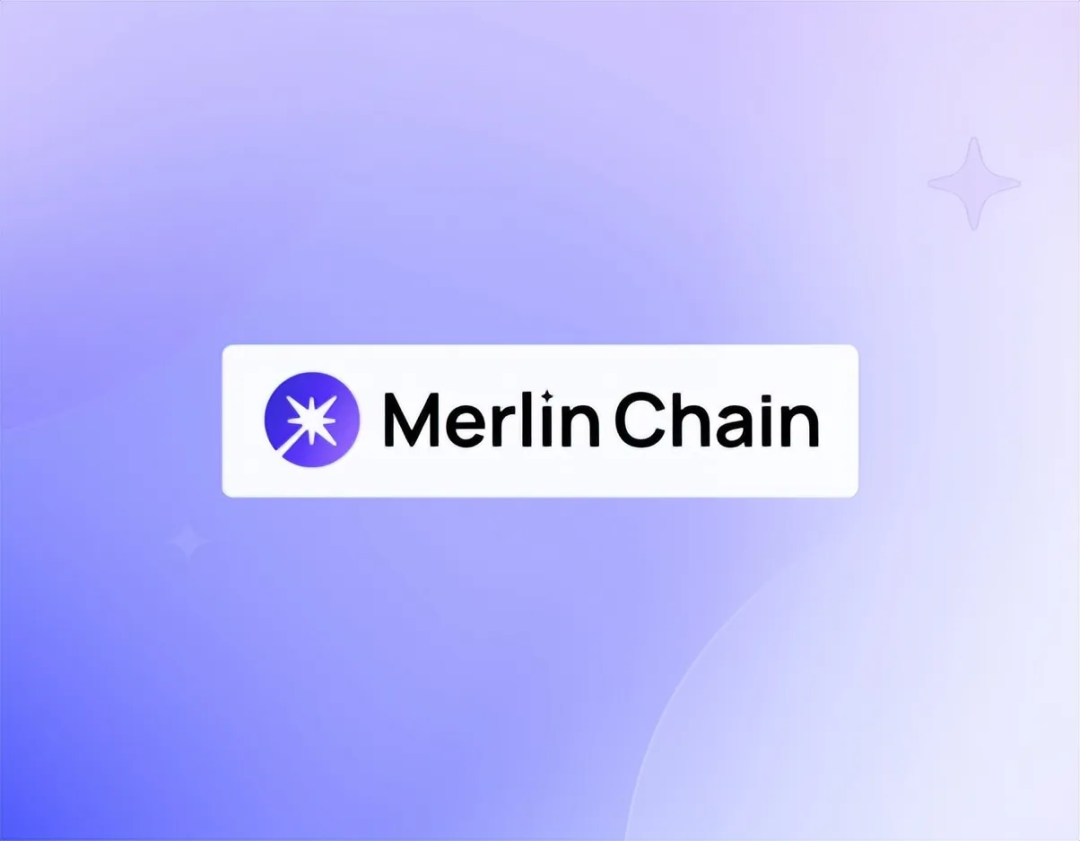
Currently, in the Bitcoin Layer 2 arena, Merlin Chain has the highest TVL, reaching several billion dollars, making it the most attention-grabbing project in the Bitcoin ecosystem. As a Bitcoin Layer 2 network, Merlin Chain supports various native Bitcoin assets and is also compatible with EVM, demonstrating its dual focus on the Bitcoin and Ethereum ecosystems.
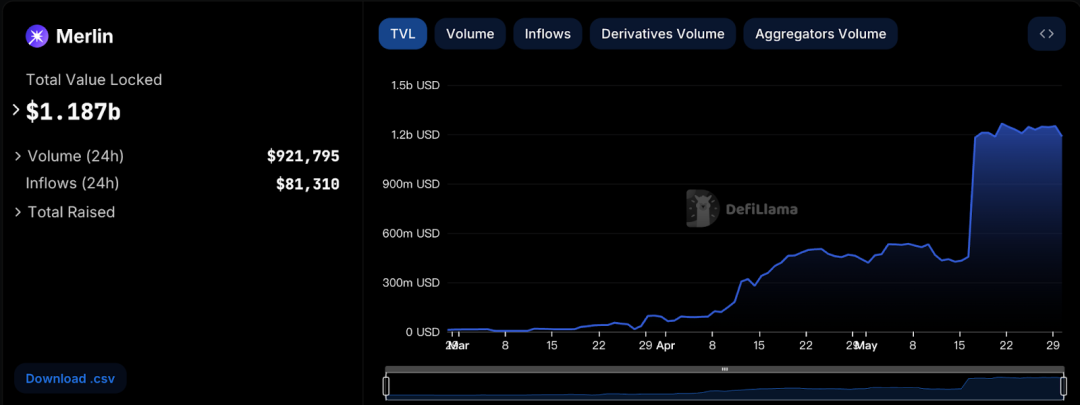
Source: https://defillama.com/chain/Merlin
Merlin's features revolve around the ZK-Rollup network, decentralized oracle network, and on-chain anti-fraud measures.
ZK-Rollup Network
The core of ZK-Rollups lies in the use of zero-knowledge proofs. Zero-knowledge proofs, as a cryptographic encryption method, allow one party (the prover) to prove a statement to another party (the verifier) without revealing any information other than the fact that the statement is true.
Merlin Chain processes and computes transactions off-chain, avoiding high transaction fees and network congestion on the Bitcoin network. Additionally, ZK-Rollup can compress multiple transaction proofs into batches, with the Bitcoin main chain only needing to verify a single proof containing multiple transactions, significantly reducing the workload on the main chain and improving transaction efficiency.
Decentralized Oracle Network
Merlin's decentralized oracle network acts as a Data Availability Committee (DAC) to check and ensure that the sequencer has accurately published complete DA data off-chain. The decentralized nature of the oracle network lies in its use of a proof-of-stake (POS) mechanism, allowing anyone to run an oracle node by staking sufficient assets. This staking mechanism is highly flexible, supporting assets such as BTC, MERL, and also supporting proxy staking similar to Lido.
On-Chain Anti-Fraud Measures
Merlin adopts the BitVM approach, similarly using an "optimistic ZK-Rollup" mechanism, which can be understood as assuming all ZK Proofs are trustworthy by default, only penalizing operators in case of errors. Because verification occurs on the Bitcoin mainnet, due to technical limitations, it is not possible to fully verify ZK Proofs on the Bitcoin chain, and can only verify a specific step of the ZK Proof's computation process in special cases. Therefore, people can only point out errors in a specific computation step of the ZKP during off-chain verification and challenge it through fraud proofs.
4.2.2 Data Availability Layer & Consensus Layer
B² Network

B² Network adopts a modular design, with the Rollup layer (ZK-Rollup) responsible for execution, the data availability layer (B² Hub) responsible for data storage, B² Nodes for off-chain verification, and the final settlement layer being the Bitcoin mainnet.
The ZK-Rollup layer of B² Network uses the zkEVM solution to execute user transactions within the second-layer network and output relevant proofs. The Rollup layer is responsible for submitting and processing user transactions, while the DA layer is responsible for storing copies of aggregated data and verifying relevant zero-knowledge proofs.
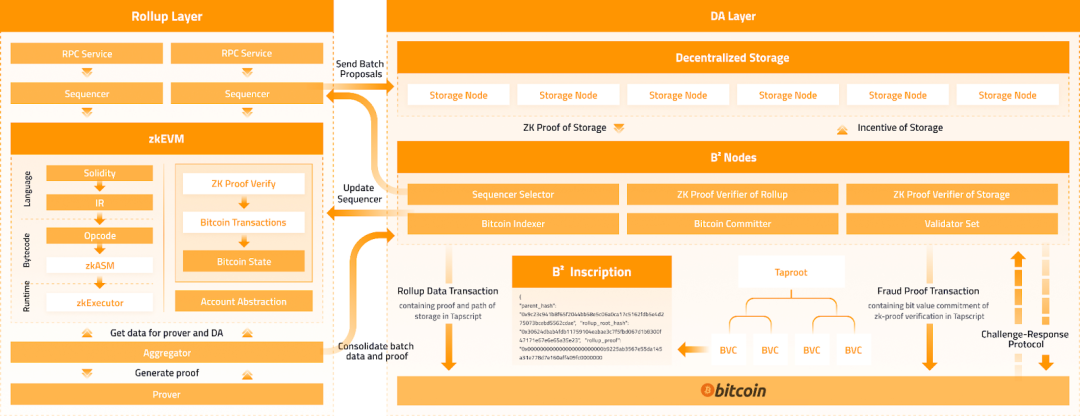
Source: https://docs.bsquared.network
B² Hub is a DA network built off-chain, supporting data sampling functionality, and is seen as a pioneer in modular Bitcoin expansion solutions. B² Hub draws inspiration from Celestia's design approach, introducing data sampling and erasure coding technology to ensure rapid distribution of new data to numerous external nodes and minimize the risk of data withholding. Additionally, the Committer in B² Hub uploads storage indexes and data hashes of DA data to the Bitcoin chain for public access.
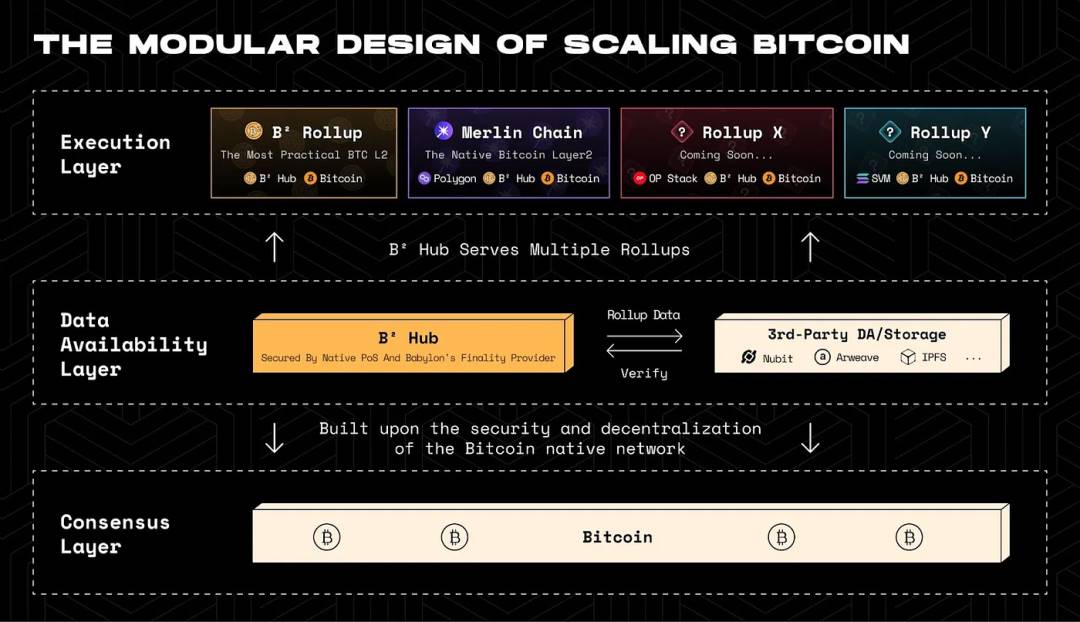
Source: https://blog.bsquared.network
According to B² Network's future plans, the EVM-compatible B² Hub is expected to become the off-chain verification layer and DA layer for multiple Bitcoin Layer 2 solutions, forming a functional extension layer for Bitcoin off-chain. Given that Bitcoin itself cannot support many use cases, the method of building a functional extension layer off-chain is becoming increasingly common in the Layer 2 ecosystem.
B² Hub, as the first modular third-party DA layer for Bitcoin, can help other Bitcoin Layer 2 solutions utilize the Bitcoin mainnet as the final settlement layer and inherit Bitcoin's security, thus promoting the expansion of the Bitcoin network and enhancing the diversity of its applications.
5. Conclusion
The slogan "Modular is the future" is gradually turning from an idea into reality. Modular blockchain technology, with its flexibility and scalability, provides a solid foundation for building the next generation of decentralized applications. This technology allows developers to choose and combine different modules according to specific needs, creating more efficient, secure, and easily maintainable blockchain solutions.
The rise of modular blockchain represents a more "soulful" plug-and-play product concept. In this approach, blockchain is no longer seen as a closed system, but as an open, scalable platform where various services and functions can be easily inserted and removed like LEGO bricks. This flexibility enables developers to quickly build and deploy blockchain solutions based on the specific needs of application scenarios.
Originating from the Ethereum ecosystem and now making its mark in the Bitcoin ecosystem, modular technology has demonstrated its capabilities in various tracks of the cryptocurrency industry.
For example, Chromia, a modular public chain using "relational database" technology, has collaborated with multiple games in the gaming industry such as My Neighbor Alice and Chain of Alliance. In the RWA track, Chromia has created the Ledger Digital Asset Protocol, and several projects have adopted this protocol.
In the AI field, CARV focuses on building a modular data layer for AI and Web3 games, ensuring privacy and security in the data processing process through technologies such as Trusted Execution Environment (TEE) and zero-knowledge proofs.
As modular blockchain technology continues to mature and expand into various application areas, we have reason to believe that this technology will bring more possibilities for innovation across industries. From the birth of Bitcoin to the widespread application of modular blockchain today, we have witnessed how blockchain technology has evolved from a single digital currency application to an ecosystem supporting complex and diverse applications. In the future, modular blockchain will continue to drive technological progress and lay the foundation for building a more open, flexible, and secure digital world.
免责声明:本文章仅代表作者个人观点,不代表本平台的立场和观点。本文章仅供信息分享,不构成对任何人的任何投资建议。用户与作者之间的任何争议,与本平台无关。如网页中刊载的文章或图片涉及侵权,请提供相关的权利证明和身份证明发送邮件到support@aicoin.com,本平台相关工作人员将会进行核查。




